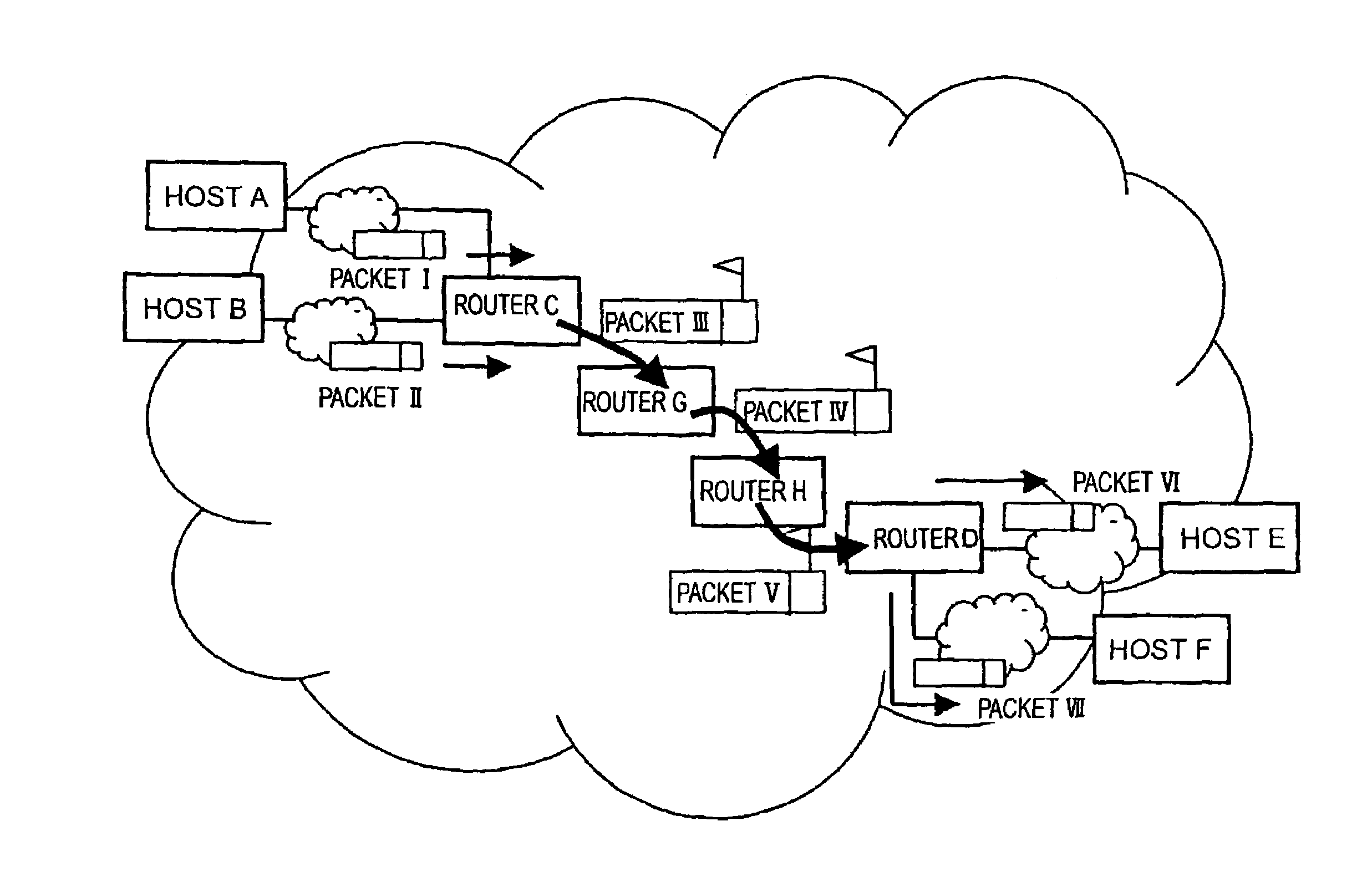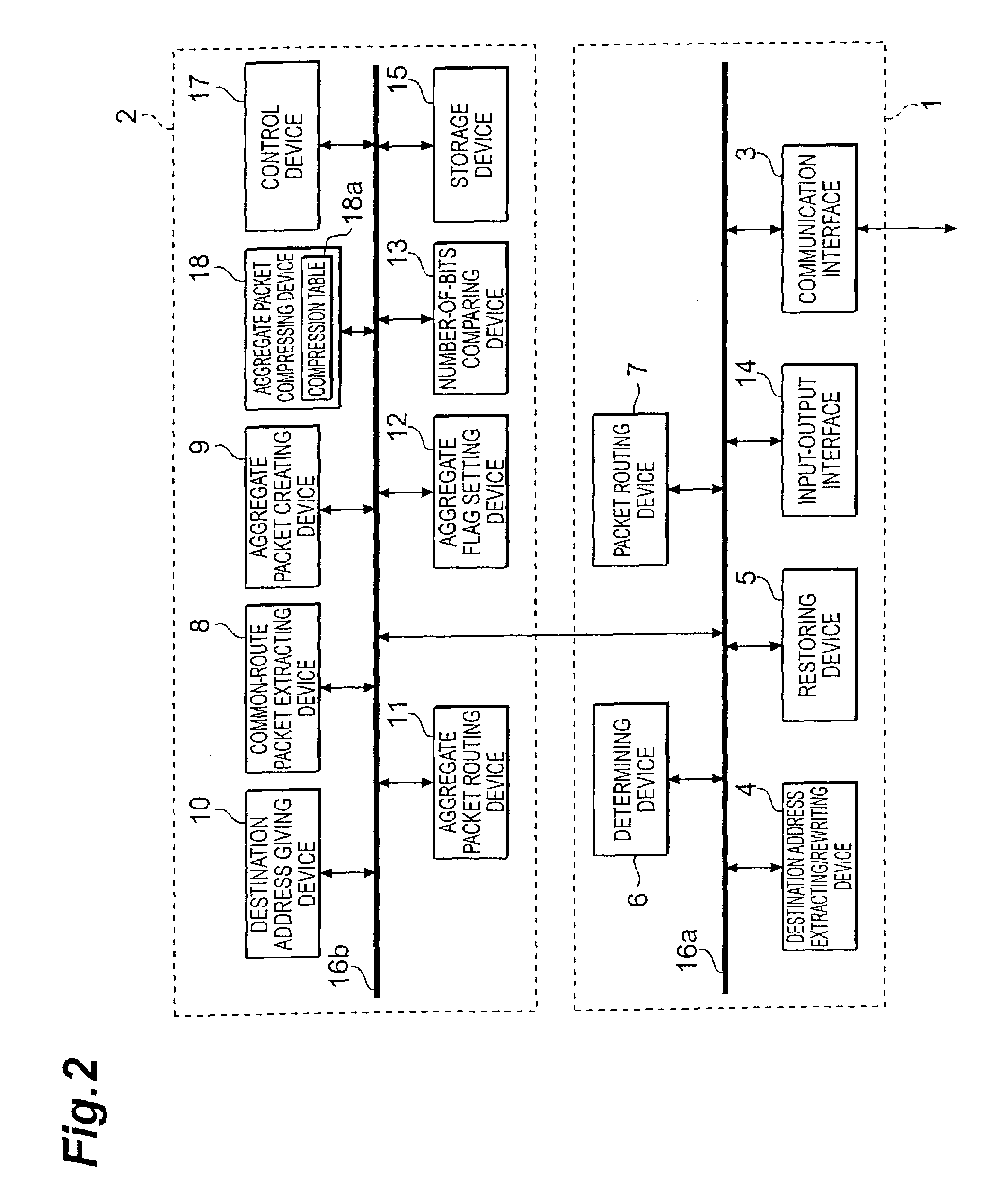Routing method, node, packet communication system, program, and recording medium
a routing method and packet communication technology, applied in the field of routing methods, nodes, packet communication systems, programs, and recording media, can solve the problems of link layer headers and link band oppression, and achieve the effects of reducing processing load, reducing the total number of packets transmitted, and reducing the number of references to the routing tabl
- Summary
- Abstract
- Description
- Claims
- Application Information
AI Technical Summary
Benefits of technology
Problems solved by technology
Method used
Image
Examples
first embodiment
[0068]FIG. 1 is a diagram schematically showing a packet communication system as a first embodiment of the present invention. The nodes in the first embodiment are configured to capsule two or more IP packets together under an IP header to create an aggregate packet. The system herein is constructed on the premise that routing protocols such as OSPF (Open Shortest Path First) and others are active on the network. In FIG. 1, all the routers in the network have a restoring function of restoring an aggregate packet to a plurality of original packets. For example, they are routers C, D, G, and H in FIG. 1. The routers C and H also have an IP capsuling function, i.e., a packet aggregating function of aggregating two or more packets to create one aggregate packet, in addition to the restoring function. The routers G and D having only the restoring function are configured to execute the restoring flow shown in FIG. 4, for each of received packets. The routers C and H having the restoring f...
second embodiment
[0114]FIG. 13 is a diagram schematically showing a packet communication system as a second embodiment of the present invention. In the second embodiment, two or more IP packets are capsuled together under one IP header to create an aggregate packet. The system is configured on the premise that the routing protocols such as OSPF and others are active on the network and that the routers having the aggregating function preliminarily know the network topology and which node has the restoring function. It is also possible to manually set the network topology and the nodes with the restoring function, for each of the routers having the aggregating function. The router G in the network has neither the restoring function nor the aggregating function. The router H has only the restoring function by decapsuling. The router C and the router D have both the aggregating function by capsuling and the restoring function by decapsuling. Here the aggregating function is a function of executing the p...
third embodiment
[0129]FIG. 18 is a diagram schematically showing a packet communication system as a third embodiment. of the present invention. In the above-described first embodiment and second embodiment, the aggregate IP packet was created by capsuling of two IP packets, but it is also possible to create an aggregate Ethernet (registered trademark) frame from two IP packets without use of the capsuling technology. In the third embodiment, an aggregate Ethernet frame is created from two IP packets. The system is based on the premise that the routing protocols are used on the network, as in the conventional Internet.
[0130]Here the routers A and B have the aggregating function of an Ethernet level and all the routers on the network have the restoring function. The aggregating function of the Ethernet level herein is a function of executing the processing shown in the flowchart of FIG. 19. The restoring function of the Ethernet level is a function of identifying an aggregate flag of an aggregate Eth...
PUM
 Login to View More
Login to View More Abstract
Description
Claims
Application Information
 Login to View More
Login to View More - R&D
- Intellectual Property
- Life Sciences
- Materials
- Tech Scout
- Unparalleled Data Quality
- Higher Quality Content
- 60% Fewer Hallucinations
Browse by: Latest US Patents, China's latest patents, Technical Efficacy Thesaurus, Application Domain, Technology Topic, Popular Technical Reports.
© 2025 PatSnap. All rights reserved.Legal|Privacy policy|Modern Slavery Act Transparency Statement|Sitemap|About US| Contact US: help@patsnap.com



